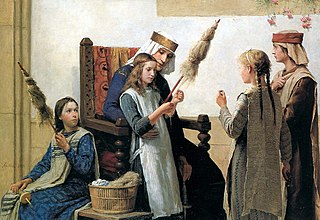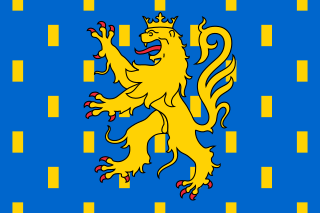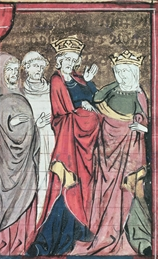
Adelaide of Italy, also called Adelaide of Burgundy, was Holy Roman Empress by marriage to Emperor Otto the Great. She was crowned with him by Pope John XII in Rome on 2 February 962. She was the first empress designated consors regni, denoting a "co-bearer of royalty" who shared power with her husband. She was essential as a model for future consorts regarding both status and political influence. She was regent of the Holy Roman Empire as the guardian of her grandson in 991–995.

The Salian dynasty or Salic dynasty was a dynasty in the High Middle Ages. The dynasty provided four kings of Germany (1024–1125), all of whom went on to be crowned Holy Roman emperors (1027–1125).
The 960s decade ran from January 1, 960, to December 31, 969.

Year 937 (CMXXXVII) was a common year starting on Sunday of the Julian calendar.
Amadeus II was the count of Savoy from 1078 to 1080. His life is obscure and few documents mention him. During his rule, he was overshadowed by his mother, but he had good relations with the papacy and, for a time, the Holy Roman emperor.

The Free County of Burgundy was a medieval feudal state ruled by a count from 982 to 1678. It was also known as Franche-Comté, from French: franc comte meaning 'free count', and was located in the modern region of Franche-Comté. It bordered the Duchy of Burgundy to the west, which was part of France from 843.

Adelaide del Vasto was countess of Sicily as the third spouse of Roger I of Sicily, and Queen consort of Jerusalem by marriage to Baldwin I of Jerusalem. She served as regent of Sicily during the minority of her son Roger II of Sicily from 1101 until 1112.
William V of Montferrat also known regnally as William III of Montferrat while also referred to as William the Old or William the Elder, in order to distinguish him from his eldest son, William Longsword, was seventh Marquis of Montferrat from 1135 to his death in 1191. William was the only son of Marquis Renier I and his wife Gisela, a daughter of Count William I of Burgundy and widow of Count Humbert II of Savoy. It seems likely, given that he was still fit enough to participate in battle in 1187, that William was one of his parents' youngest children.
The Elder House of Welf was a Frankish noble dynasty of European rulers documented since the 9th century. Closely related to the Carolingian dynasty, it consisted of a Burgundian and a Swabian group. It has not been definitively clarified, however, whether the two groups formed one dynasty or whether they shared the same name by coincidence only. While the Elder House became extinct in the male line with the death of Duke Welf of Carinthia in 1055, his sister Kunigunde married into the Italian House of Este and became the ancestor of the (Younger) House of Welf.
William III was the third Marquis of Montferrat and Count of Vado from 991 to his death. He was the eldest son and successor of Otto I. William I and II were the father and son, respectively, of Aleram, the first Marquis, but neither served as Marquis himself.
Oberto I Obizzo was an Italian count palatine and margrave and the oldest known member of the Obertenghi family.
Henry del Vasto, died before 1141 was a son of Manfred del Vasto, margrave of Western Liguria, and brother of Adelaide, countess of Sicily (1089–1117) and Jerusalem (1112–1117) and of Boniface, margrave of Savona and Western Liguria.
The House of Obertenghi were a prominent Italian noble family of Frankish origin descended from Viscount Adalbert III, first Margrave of Milan.
The March or Marquisate of Turin was a territory of medieval Italy from the mid-10th century, when it was established as the Arduinic March. It comprised several counties in Piedmont, including the counties of Turin, Auriate, Albenga and, probably, Ventimiglia. The confines of the march thus stretched across the Po Valley from the Western Alps in the north, to the Ligurian Sea.
Otto I was the second Marquis of Montferrat briefly following his father Aleram on the throne.

The Aleramici were a Northern Italian noble and royal dynasty of Frankish origin which ruled various northwestern Italian territories in Piedmont and Liguria from the 10th to the 14th century, also reigning over the Kingdom of Jerusalem and the Kingdom of Thessalonica during the 12th and 13th centuries.

The Marchof Montferrat was a frontier march of the Kingdom of Italy during the Middle Ages and a state of the Holy Roman Empire. The margraviate was raised to become the Duchy of Montferrat in 1574.

The Marquisate of Finale was an Italian state in what is now Liguria, part of the former medieval Aleramici March. It was ruled for some six centuries by the Aleramici branch known as marquesses del Vasto and later Del Carretto, when Savona became a free commune. In 1598 the Marquisate was sold by its last marquis, Sforza Andrea to Philip II of Spain and in 1713 it was finally ceded to the Republic of Genoa, where it remained so until 1797, when it was invaded by Napoleon, ceasing its existence.

The House of Palaeologus-Montferrat or Palaiologos-Montferrat, or just Palaeologus or Paleologo, was an Italian noble family and a cadet branch of the Palaiologos dynasty, the last ruling family of the Byzantine Empire. The cadet branch was created in 1306 when Theodore Palaiologos, fourth son of Byzantine Emperor Andronikos II Palaiologos, inherited the March of Montferrat through his mother, and Andronikos II's second wife, Yolande of Montferrat.









